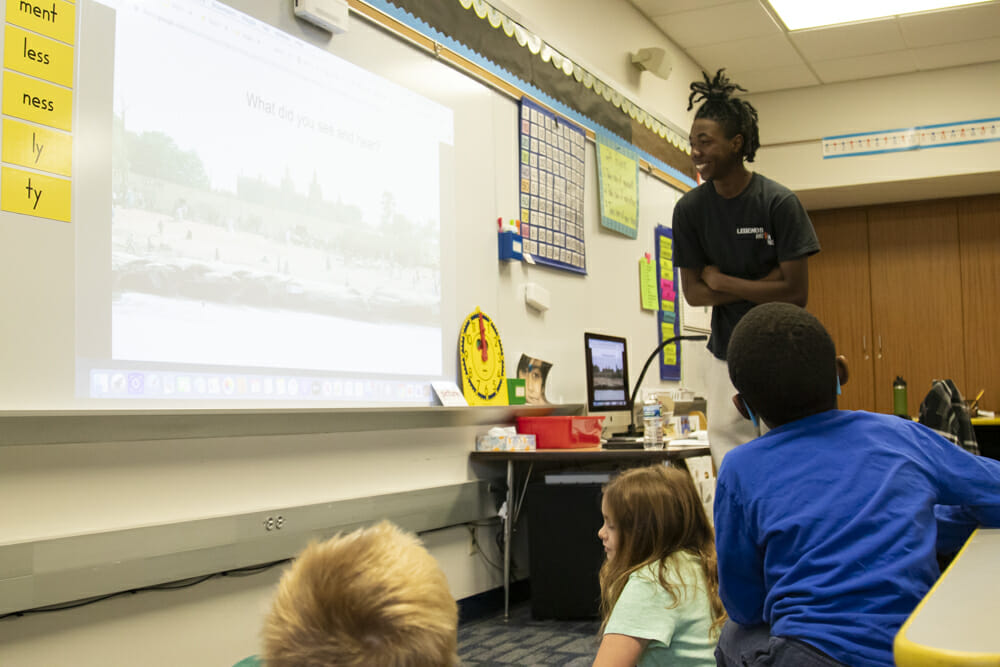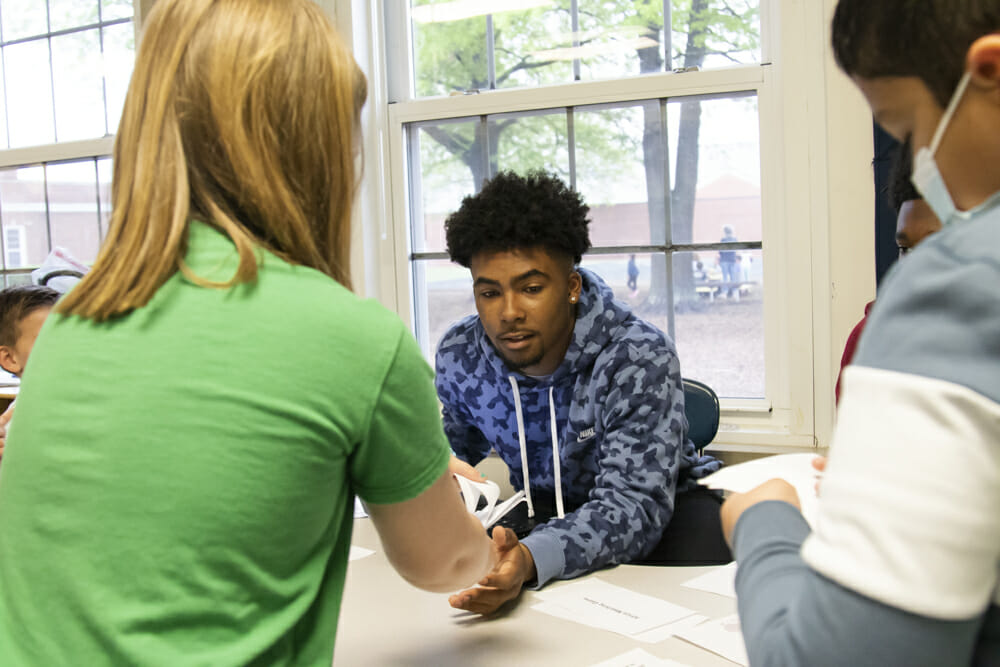Upper School History Teacher Alex Rolnick knows that one of the best ways to show a firm grasp of subject matter is to teach it, and he challenged the students in his History of Africa class to do just that. Their audience? Second-grade friends in Beasley. The timing was perfect as the Lower School class was conducting its own study of Africa this spring. Rolnick explained, “My primary goal was for students to adapt and share content knowledge at an audience-appropriate level and to practice purpose and service-driven education.”
First, to help the older students better understand where their young pupils were, Second-Grade Teachers Nicole Skaggs and Maggie Kraushaar asked their students what they already know about Africa and what they were curious to learn more about. Second graders know that Africa has all four seasons, that there is a variety of animals that live there (and some animals that live only there), that African people speak many different languages, that there are sometimes droughts in the dry season, that Madagascar and Zimbabwe are both parts of Africa, and that cricket is a major sport there, among other things. What are they curious about? They want to know more about transportation, education, animals and insects, food, languages, technology, clothing, plant life, and geography. How long is the school day? Do they have the same books? Do they speak English? Do they have different letters? Do they have internet and use cell phones? Do they wear uniforms at school? What types of plants grow there? How many countries are in Africa? What is the population?
The Upper School students partnered up and each team identified a focus area based on this information. Rolnick said, “In focusing on music from Mali to Nigeria, schools, and education from Kenya to South Africa, and so much more, my students helped bring a nuanced perspective on life on the other side of the world to a group of students who were excited to be learning from ‘big kids.'”
Binta Fall ’23 wondered how teaching younger students would go. “When Mr. Rolnick first introduced the project to the class, I was a bit concerned about the aspect of being able to keep second graders engaged,” she said. “After doing some preliminary research about how to keep kids engaged in a classroom setting, my partner and I came up with some fun ideas. We started with the idea of introducing African foods to the kids while also teaching them about geography, climate, and flags. The coloring pages, word searches, and pamphlets helped keep them engaged in our lesson, and I think that it went really well. I’ve learned that working with kids is kind of a spur-of-the-moment experience because they tend to say and do whatever is on their minds. I’m glad that I got to experience each student’s individual creativity.”
“One way to work on having students learn in purpose-driven ways is for the students themselves to be agents of change. In this case, they worked to share knowledge that combats the development of narratives that reduce Africa and Africans to negative or sad images in the media,” said Rolnick.
Each team had two goals:
- Inform your audience of seven- and eight-year-olds about something they should know—to motivate interest in the African continent, and present this information with nuance to avoid a “single story” representation of Africa or Africans. Given the audience, the Upper School students needed to keep in mind that developmentally speaking, second-graders aren’t ready for graphic violence and mass death. Rolnick cautioned them, “If you pick a ‘heavy’ topic, you need to figure out how to infuse hope and positivity, or depict it through a metaphor.”
- Engage and entertain. If the second graders don’t engage with the material, they won’t be motivated to learn. The older students needed to consider what activities or discussion topics they could prepare to make the experience an exciting and interesting one for their younger schoolmates.
Students were encouraged to approach the project creatively and consider a variety of formats to share information: a picture book or comic book; an illustrated poem or rap; a multimodal presentation, theatrical performance, or sock puppet production; or a card or board game.
Kavin Hardison ’23 came prepared with a variety of African music to share. “Going into this project, I was just trying to make something entertaining, engaging, and enjoyable,” he said. “It went surprisingly well because I didn’t know exactly how the kids would answer my questions or react to the music I played. They were very responsive to the questions I asked and were happy to interact with me. I think that my favorite part had to have been asking those questions; especially the first one when I asked what they knew about African music.”
“I thought the project went well!” said Rolnick. “I think my favorite moment was Kavin Hardison playing music videos from a few different countries to illustrate the diversity of music across the continent and the impromptu dance parties that started for the songs the second graders liked. That definitely doesn’t happen in my classes in the Upper School. There was so much positive energy and excitement in the second-grade classrooms.”
Rolnick’s motivation behind the class comes from his personal experience. “Many Americans have significant blind spots in their knowledge of the African continent, which is often misrepresented and misunderstood in the United States,” he said. “Until I went to college, the main things I knew about Africa focused on disease and conflict. I had what Chimamanda Ngozi Adichie has famously called a ‘single-story view’ of the continent. In college, I was lucky to end up having a fantastic professor from Nigeria whose classes completely reframed my view of the continent, and then to learn from living and teaching in Tanzania and Somaliland, but the ‘single story’ persists for many people.”
“Personally, our time spent with the second-grade students and classroom went extremely well because for each group, the main goal was to keep the children attentive and interested in what we were presenting,” said Emily Podgorny ’23. “My group was presenting about education in Africa and without merely creating a presentation, we had the idea to create a Kahoot to see where they stood on what they originally knew, and then a packet with activities for them to complete after! Each child brought so much energy and it was so fun to see how excited they got to learn something new.”
Fall enjoyed her experience and learned from her students. She said, “My favorite part was hearing the kids ask clarifying questions about what foods/geography look like in Africa because it allowed me to observe the immense amount of curiosity that the kids hold. Being able to contribute to teaching the kids about the sometimes hidden realities in Africa (rather than inaccurate representations/misconceptions) was a very perceptive experience, and I hope that Mr. Rolnick continues to do this project in future African History classes!”


































